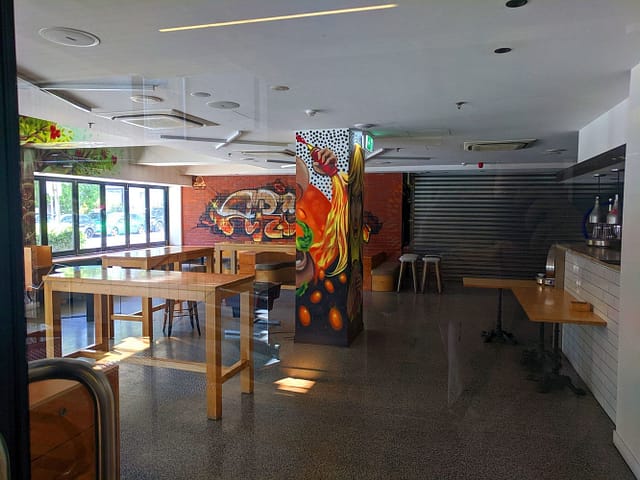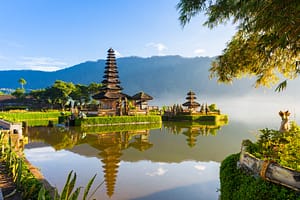We explore the artwork of TRYP by Wyndham Fortitude Valley Hotel Brisbane.
If you haven’t visited TRYP Brisbane before, you might expect something in the vein of a typical Wyndham property – sleek, five-star luxury, chrome highlights and modernist trappings.
It’s not. Right from the moment you walk through the glass doors off the sidewalk of Constance Street, TRYP surprises.
Reception greets you as you step inside, the TRYP logo affixed to a fashionably weathered brick wall behind them. To the right, a winding staircase and an elevator; to the left, a sprawling, mural-decorated room that’s set to be refurbished into a coffee house for Dirty Sultan, TRYP Brisbane’s rooftop shisha bar.

The walls are hung with an eclectic array of paintings, most of them works from Australian street artists who earned their stripes tagging inner-city walls. There’s even a section of original brickwork from 1955 featured at the entrance, replete with authentic graffiti.

It all works together to create a visceral ambience, a sense that this is not just a place to sleep, but a step into a different world, an urban microcosm of bold colours and raw, striking designs.
Right away, you know that a stay at TRYP isn’t like a stay at other hotels.
Going Up
TRYP is six storeys high – ground level belongs to reception and the soon-to-be café, followed by four levels of accommodation, before being capped off by Dirty Sultan. True to its hip aesthetic, each one of the four accommodation levels features work by a different artist, including framed artwork, floor-to-wall murals and in-room designs printed onto the wallpaper.
Ascending is a journey. Whether you’re walking up the spiralling staircase – coiled around a central cage of blackened steel – or standing in the glass elevator – which passes original brick walls covered in art – going up is, in itself, a form of exploration.
The First Floor
On the first floor, you’re greeted by staircase art from Bao Ho, a Hong Kongese artist who painted the mural during the 2017 Brisbane Street Art Festival.

Opposite her cartoonish kitties is TRYP’s own in-house library, each letter delineated by a different colour. The library also includes a casual meeting room and a cosy reading corner, complete with a TV and faux-fireplace – perfect for escaping Brisbane’s inner-city bustle.


The rest of the first floor is the domain of Tyrone Wright, known on the graffiti scene as Rone, one of Melbourne’s most high-profile and prolific street artists. His works are mostly of the female face, best encapsulated in his famous ‘Jane Doe’ series.

Each piece finds a balance between the natural beauty of his inspirations and something darker – there’s a hint of submerged anger in some, a quiet sadness in others.

Walking between them – women trapped beneath pipes, or staring forlornly into the distance – isn’t a relaxing experience.

The end of the corridor features a full-length mural, a hard-eyed belle rendered in shades of crimson, which is arguably the most disconcerting of them all.

It’s on the first floor that you can stay in the King Rooms with Courtyards, each space enhanced by private, art-adorned courtyards. The concrete walls are covered in psychedelic coils of colour created by Sydney artist Beastman, broken up by some gentler scenes of floating clouds from Brisbane-born Fintan Magee.

The Second Floor
Magee makes himself known on the second floor with surrealist pieces that deviate from his street-art roots. Where Rone disturbs, Magee confounds. The piece that greets you as you step off the elevator is a man in a flanny holding a townhouse above a seated boy’s head.

Other paintings include a boy building a sandcastle as another, older child suspends him on a tabletop, and the painting at the end of the corridor – a boy gazing at a sky of dust clouds and stars as he perches on a fuel drum that’s supported by a crouching drover.

Do they make sense? Maybe – interpretation lies with the audience. But even if you look at them and think they’re nonsense, fever-dreams brought to life by a skilled hand, you can’t deny the feeling they bring – a strange nostalgia from an alternate Australia.
The Third Floor
The third floor is enveloped by the tentacled lines and geometric patterns of Beastman, whose bold, bright pieces are a stark contrast to the more sombre works of Magee and Rone. Eyes and fangs push through nests of coils, almost spilling beyond the confines of the frame, so that each step seems watched by the hungry gaze of a multi-coloured leviathan.
It’s worth noting here that each room in TRYP features custom glass handbasins, decorated with graffiti-style renderings of ‘TRYP’. Some of the showers have similarly adorned curtains, adding to the colourful wallpaper and in-room paintings.
The Fourth Floor

Elliot ‘Numskull’ Routledge composes pieces that tie restless abstractionism together with typographical forms and notions of idolism. His works are often simplistic – many resemble particoloured cut-outs pasted together on a blank white canvas or Microsoft Paint-style squiggles. Smiley faces are a frequent motif as well, appearing on heroes’ shirts or in lieu of Bart Simpson’s eyes. Many of Numskull’s street works have been photographed and framed for the fourth floor, but individual rooms also feature wallpapers and paintings.
Visiting TRYP isn’t for everyone. The colours might be too bright, the artwork too strange. Maybe the mashup of urban grunge and Wyndham sophistication is difficult to swallow. But, for most travellers, staying at TRYP Brisbane is a journey, an exploration of mental corridors as much as physical ones. To book a room is to touch the streets, to feel the vibrant energy that seethes in the underground of Australian cities. So go. Savour TRYP. The art scene you haven’t seen is here, waiting, in all its raw, untrammelled glory.






